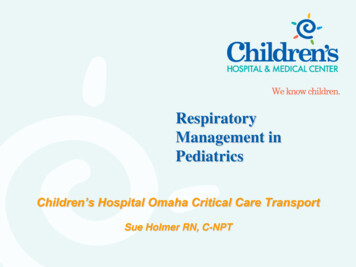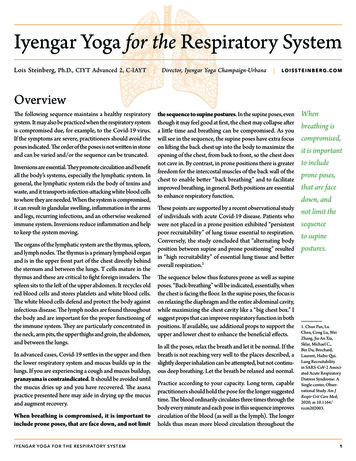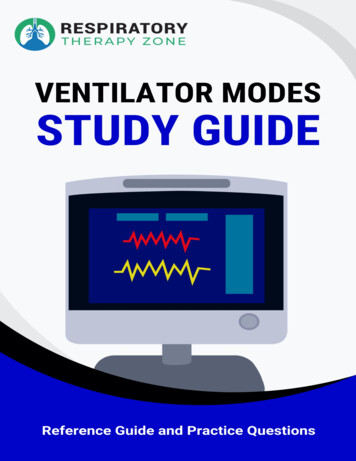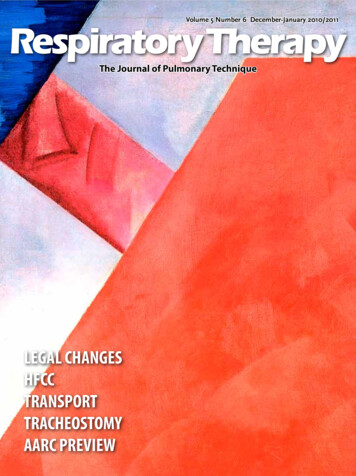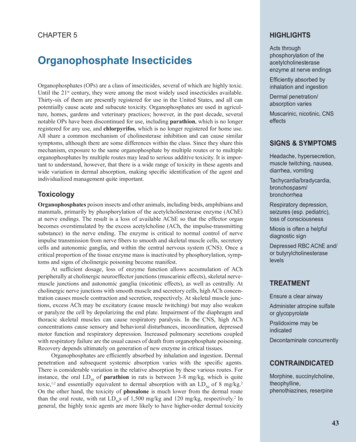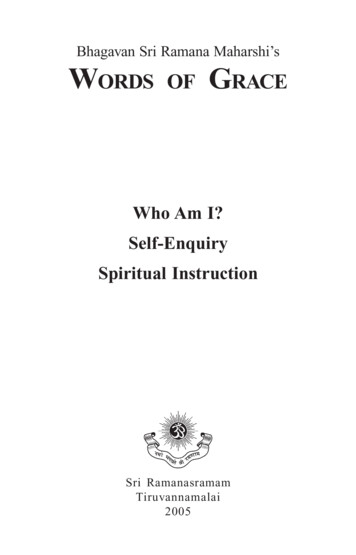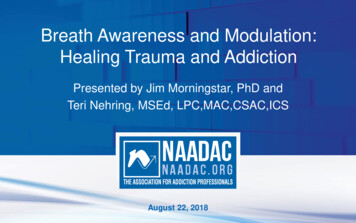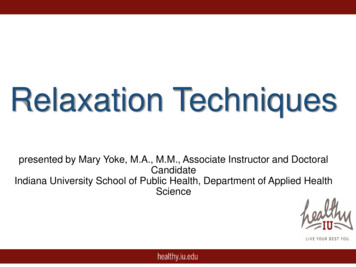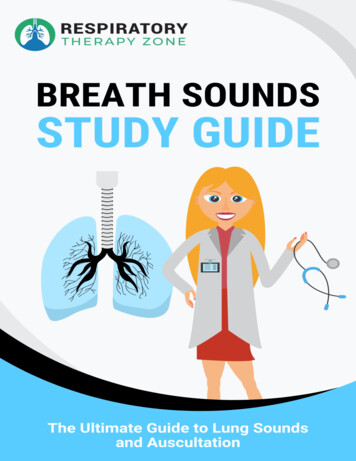
Transcription
Disclaimer:Medicine and respiratory therapy are continuously changingpractices. The author and publisher have reviewed all informationin this report with resources believed to be reliable and accurateand have made every effort to provide information that is up todate with the best practices at the time of publication. Despite ourbest efforts we cannot disregard the possibility of human errorand continual changes in best practices the author, publisher, andany other party involved in the production of this work canwarrant that the information contained herein is complete or fullyaccurate. The author, publisher, and all other parties involved inthis work disclaim all responsibility from any errors containedwithin this work and from the results from the use of thisinformation. Readers are encouraged to check all information inthis publication with institutional guidelines, other sources, and upto date information. Respiratory Therapy Zone is not affiliated withthe NBRC , AARC , or any other group at the time of thispublication.Copyright ã Respiratory Therapy Zone2
Table of ContentsIntroduction . . .4Breath Sounds: An Overview . . .5TMC Practice Questions . . . .17More Practice Questions . . . .22Conclusion . . . .26References . . . .28Copyright ã Respiratory Therapy Zone3
IntroductionAre you ready to learn the ins and out of breath sounds andauscultation? I sure hope so because that is what this study guideis all about.As a Respiratory Therapist (or student), it goes without saying thatyou absolutely must fully know and understand everything thereis to know about breath sounds.The good news is — we created this study guide to help you dojust that.So if you’re ready, let’s go ahead and dive right in!Copyright ã Respiratory Therapy Zone4
Breath Sounds: An OverviewBreath sounds are the noises that come from your lungs whenyou inhale and exhale. Any abnormality in breath sounds indicatesa problem in the lungs such as: Accumulation of fluidAsthmaChronic obstructive pulmonary disease (COPD)Foreign body in the lungs or airwaysHeart failureInfectionInflammation of the airwaysObstructionPneumoniaBy listening to the quality, duration, and intensity of breathsounds, healthcare providers can come up with a proper diagnosisand medical management.What is Auscultation?Auscultation is a simple, non-invasive procedure that involves theuse of a stethoscope to listen to the sounds produced by the body.For the sake of this guide, we’re focusing specifically on the lungs.A stethoscope is used to amplify the sounds within the lungs sothat you can listen and get idea of what’s going on inside.This is precise why Respiratory Therapist and medicalprofessionals should invest in a high-quality stethoscope.Click Here to See Our Top Recommend StethoscopesWhen performing lung auscultation, the bell or diaphragm of thestethoscope is placed on the patient’s chest and/or back. Both5
sides can be compared with one another. Not only that, thesounds within each lung should be compared as well.Types of Breath Sounds:As a medical professional, you have to be able to differentiate thedifference between all the different types of breath sounds.Here are the lung sounds that you should be familiar with:1. Vesicular (Normal)Vesicular or normal breath sounds are usually soft and lowpitched. They are heard over the auscultation of the chest andlung surfaces of a healthy person.The sound typically has a rustling quality during inspiration. This isgenerated by turbulent airflow within the lobes of the lungs.During expiration, the sound becomes softer as air flows withinthe larger airways. The inhalation process is normally 2-3 times thelength of the exhalation process.2. Crackles (Rales)Crackles, also known as rales, are short, explosive, nonmusicalsounds. They are heard in lung fields that have fluid in the smallairways.Crackles can occur on both inspiration and expiration but aremore common during the inspiratory phase.There are two types of crackles: Fine crackles Coarse crackles6
The difference between the two is that fine crackles have a higherfrequency and a shorter duration. They are caused by a suddenopening of a narrowed or closed airway.The sound of fine crackles can be compared to that of salt heatedon a frying pan.Coarse crackles, on the other hand, are louder, lower in pitch andlast longer. They are caused by secretions in the airways. Thesound of coarse crackles is like pouring water out of a bottle.Crackles are often associated with lung inflammation or infection.If they do not clear after a cough, this may indicate that fluid is inthe alveoli. It could also be an indication of acute respiratorydistress syndrome or pulmonary fibrosis.3. WheezesWheezes are continuous tones that commonly occur at the end ofthe inspiratory phase or early expiratory phase. The wheezingsound is made as a result of the gradual opening or closing of acollapsed airway.Wheezes are either high-pitched or low-pitched.They sound like a whistle when you breathe and are most audibleduring the expiratory phase. Wheezing is usually caused bybronchoconstriction but can also occur when the patient is fluidoverloaded as well.Aside from narrowed airways, wheezes can also be caused byinflammation secondary to asthma and bronchitis.4. RhonchiWhen you hear rhonchi breath sounds, it typically means thatthere are secretions in the large airways. In this case, as a7
Respiratory Therapist, you should recommend bronchial hygienetherapy or suctioning.These lung sounds are often low-pitched and are audible duringthe expiratory phase. The main difference between rhonchi andwheezes is that rhonchi sounds are low and dull while wheezesare high and squeaky.Rhonchi is mainly caused by either the accumulation ofsecretions, lesions, or foreign bodies. Rhonchi is common incertain medical conditions such as pneumonia, chronic bronchitis,and cystic fibrosis.5. StridorStridor, also known as “noisy breathing”, is a high-pitched soundcaused by an upper airway obstruction. This sound is commonlyheard during the inspiratory phase but can also be present duringthe expiratory phase as well.If heard during inhalation, the airway obstruction is typically at thelevel of the vocal cords or just below the windpipe. If heard duringexhalation, the airway obstruction might be in the lower tracheaor the bronchi.Several medical conditions can cause stridor including vocal cordabnormalities, narrowing of the larynx, abnormal growth of bloodvessels, lesions, infections, and foreign bodies.When heard in adults, it’s usually caused by post-extubationlaryngeal edema.6. Pleural friction rubA pleural friction rub is a loud grating sound that is usually heardover the lower lung lobes when inflamed pleura rub together. Thislung sound is heard in patients with pleurisy.8
Because these sounds occur whenever the chest wall moves, theyare generally heard throughout inhalation and exhalation.This lung sound is almost always associated with inflammation ofserous membrane lining in the thorax known as pleurae.What are Vesicular Breath Sounds?Vesicular breath sounds are another name for normal breathsounds. They are low-pitched and sounds like you would expect airto sound as it flows through an airway.The sounds are usually soft and can be heard throughout theinspiratory and expiratory phase.What are Adventitious Breath Sounds?Adventitious breath sounds are abnormal sounds that occur overthe lungs and airways. The term “adventitious” breath soundsdescribe the additional audible lung sounds during auscultation.This includes abnormal lung sounds such as crackles (rales),wheezes, rhonchi, stridor, and pleural friction rubs — just as wediscussed earlier in this guide.Adventitious breath sounds are commonly associated with a widearray of heart and lung conditions. The type, duration, location,and intensity of each adventitious breath sounds can help thehealthcare provider determine the root cause of the patient’smedical condition.Causes of Abnormal Breath Sounds:There are several causes of abnormal breath sounds. Each ofwhich is specific to the type of breath sound the patient isexperiencing:9
Air moving through narrowed airways due to swelling orobstruction causes wheezes. Airway obstruction due to the accumulation of mucussecretions, lesions, or foreign bodies causes rhonchi. Fluid accumulation in the small airways or atelectasis causescrackles. Obstruction of the upper airway causes stridor. Rubbing of inflamed pleural surfaces against each otherduring respiration causes a pleural friction rub.There are hundreds of causes of abnormal breath sounds — theseare just a few of the common examples that you should befamiliar with.Treatment for Abnormal Breath SoundsAbnormal breath sounds are often associated with common andtreatable medical conditions. As a Respiratory Therapist ormedical professional, you will be required to recommend theproper medication or treatment for each abnormal breath sound.Here are the common treatment strategies for abnormal breathsounds:1. Metered-Dose Inhaler (MDI)This is a pressurized inhaler that delivers a bronchodilator (dilatesthe airways), corticosteroid (suppresses inflammation), or acombination of both.By opening the airways and suppressing the inflammatoryprocess, it can help restore breath sounds to normal.2. Nebulizer10
This delivers an aerosolized form of medication into the alveoli viainhalation. They are commonly used to deliver bronchodilatormedications, like albuterol, which can alleviatebronchoconstriction.Nebulizers can help deliver other medications as well which cantreat other types of abnormal breath sounds.3. Incentive spirometryThis is a simple, inexpensive, and effective tool that is useful inhelping a patient achieve normal lung function. This devicemimics natural sighing or yawning, which in turn improves lungexpansion and gas exchange.To use the device, the patient needs to place the mouthpiecespirometer in their mouth and do deep breathing exercises.4. Chest physiotherapy (CPT)This is also considered a simple and effective method ofnormalizing abnormal breath sounds.CPT includes various techniques in order to naturally clear lungsecretions through the use of vibrations or shaking.Other types of CPT include proper positioning, breathingexercises, and coughing techniques.5. AntibioticsAntibiotic therapy is designed to fight infection and destroymicroorganisms that affect lung function. By fighting theinfection, antibiotics also help with airway inflammation andsecretions which can improve abnormal breath sounds.11
What are Bronchial Breath Sounds?Bronchial breath sounds are tubular, hollow sounds that occur asa result of an abnormal increase in the transmission of airwaysounds to the chest surface.The sound is very similar to the sound produced by blowingthrough a hollow tube.These sounds are normal when heard over the trachea, butabnormal when heard over the lungs.What are Bronchovesicular Breath Sounds?Bronchovesicular breath sounds are normal sounds that are heardin the mid-chest area or over the scapula. Unlike other normalbreath sounds, bronchovesicular breath sounds have tubularquality.These sounds are the combination of bronchial breath soundsheard near the trachea and vesicular sound in the alveoli.Bronchovesicular breath sounds have equal periods of inhalationand exhalation, which means the I:E ratio is 1:1.With that said, the differences in pitch and intensity are oftenaudible during the expiratory phase.What are Diminished Breath Sounds?Diminished breath sounds are soft, distant lung sounds with alower intensity. These sounds are normally heard in patients withdecreased lung volumes.They can be heard in patients with a life-threatening obstructivecondition, but they’re also heard in other types of patients as well.12
Here are some examples: Obese patientsPatients with increased muscle massPatients air or fluid around the lungsPatients with an increased chest wall thicknessPatients with lung hyperinflationDuring diminished breath sounds, the inspiratory phase is usuallymuch longer than the expiratory phase. This means that patientwith diminished breath sounds will have an I:E ratio of 3:1.When are Coarse Breath Sounds Heard?Coarse breath sounds are actually a type of crackles/rales. Thesesounds are clicking, bubbling, or rattling sounds that occur duringthe inspiratory process when air opens closed spaces in the lungs.Coarse breath sounds are louder, low-pitched and have longerduration. Most patients with copious amounts of secretionsexhibit coarse breath sounds during auscultation of the affectedlung area.When are Pneumonia Breath Sounds Heard?Pneumonia is a respiratory infection caused by harmfulmicroorganisms and is characterized by a productive cough.Patients with pneumonia often have greenish or yellowishsecretions.If a patient has pneumonia, you will likely hear crackling, bubbling,or rumbling sounds. Wheezing is also a possibility is some areas ofthe lungs as well.Crackles in patients with pneumonia are often heard only on oneside of the chest or when the patient is lying down. In addition to13
crackles and wheezes, low-pitch rhonchi sounds may also beaudible during the expiratory phase of breathing.What are Stridor Breath Sounds?Stridor is a high-pitched lung sound that is created by an airwayobstruction. It is mostly audible during inhalation but can also beheard during exhalation in patients with a deteriorating condition.These sounds commonly occur in extubated patients as acomplication of endotracheal intubation. In children, stridor is veryaudible when lying on the back in the supine position.Some common causes of stridor include: CroupPertussisAspirationEpiglottisChokingSevere anaphylactic shockTonsillitisLaryngitisLung cancerDeviated septumBlood transfusion reactionsHow to Perform Auscultation?Auscultation is used to examine the heart and lungs but can alsobe used in the abdomen and other areas of the body with majorblood vessels.But for the sake of this article, we’re focusing strictly on the lungs.14
In order to assess a patient’s breath sounds, auscultation must beperformed using a stethoscope to hear the lung sounds. Let’s gothrough the process of auscultating a patient.Here are the Steps for Performing an Auscultation:1. Explain the procedure to the patient to establish trust andrapport.2. Stand close to the patient to gain access to the target area. Inthis case, the lungs.3. If the diaphragm is cold, warm it by rubbing the surface toavoid startling the patient.4. Place the ear-tips of the stethoscope in your ears and adjustthem as desired.5. Hold the diaphragm firmly against the patient’s skin withenough pressure and have the patient take slow, deepbreaths through an open mouth.6. Listen to the sounds and try to identify their intensity,location, strength, pattern, and duration.7. Always listen to the patient’s anterior side first. Start at theapices and then move downward to the lung bases. Thenproceed to do the same on the posterior side.8. Compare the right lung to the left lung. Also compare theanterior to the posterior side.9. Document the findings in the patient’s chart.What is the Best Stethoscope for Auscultation?In order to perform auscultation and listen to breath sounds theright way, you need the right stethoscope. Our favorite is the: 3M Littmann Classic IIIWhen it comes to getting great value at an affordable price, thisstethoscope is the best of the best. It’s our top recommendationfor medical professionals.15
While the 3M Littmann Classic III is our favorite, there are plenty ofother high-quality stethoscopes as well.Visit this link to see our Full List of High-Quality Stethoscopes tosee if yours made the cut.16
TMC Practice QuestionsNow that you have a good understanding of breath sounds andauscultation, let’s take it a step further by going through somesample TMC Practice Question on this topic.1.A 63-year-old male patient was just admitted to the ICU. Whileauscultating his lungs, you hear bronchial breath sounds overthe right lower lobe. This would indicate which of thefollowing?A. PneumothoraxB. Normal lungsC. Pleural effusion in the patient’s right lower lobeD. Consolidation in the patient’s right lower lobeBronchial breath sounds are normal when heard over the trachea.However, if you hear bronchial breath sounds over the lungperiphery, this is an abnormal finding.To get this one right, you had to know that bronchial breathsounds are sometimes heard in patients with pneumonia. And forthe TMC Exam, you must remember that patient’s withpneumonia have consolidation.A pneumothorax or pleural effusion are not identified by bronchialbreath sounds, so we can rule those out immediately.After taking everything into consideration, we know that thecorrect answer has to be D.The correct answer is: D. Consolidation in the patient’s right lowerlobe17
2.A patient that is having an asthma attack arrives to theemergency room in respiratory distress with diminished breathsounds. After continuous bronchodilator therapy, auscultationreveals wheezing. This change suggests which of thefollowing?A. The onset of pneumoniaB. The development of a pneumothoraxC. The improvement of air flowD. The development of pulmonary edemaYou must know that a patient who is having an asthma attackwith diminished breath sounds — this is a sign of severebronchoconstriction.After bronchodilator therapy, the patient, whose breath soundswere diminished, is now wheezing. Although wheezing isabnormal, this finding suggests that the patient’s air flow hasimproved and their airways have opened up some thanks to thebronchodilator therapy.None of the other answer choices really make sense in thissituation, so we know that the correct answer has to be C.The correct answer is: C. The improvement of air flow3.A patient was just orally intubated with an endotracheal tube.Which of the following should you INITIALLY perform toconfirm that the tube is in the proper position?A. Auscultate the chest and abdomenB. Perform a STAT chest x-rayC. Use capnography to verify exhaled CO2D. Observe chest wall movementFor the TMC Exam, you must know how to confirm that the tube isin the proper position. This question is tricky because the answer18
choices are all correct methods of confirming tube placement. Thequestion requires that you know which one to perform FIRST.So immediately after intubation, the first thing you should do isauscultate the lungs to listen for bilateral breath sounds. Youshould auscultate the abdomen as well and there should be no airmovement, otherwise, you can suspect that the tube is in theesophagus instead of the trachea.All of the answer choices should be performed, just know thatauscultation should be performed first. That means that thecorrect answer has to be A.The correct answer is: A. Auscultate the chest and abdomen4.You heard bronchial breath sounds over the patient’s rightmiddle lobe while performing a routine assessment. Due tothis finding, which of the following conditions would youexpect to be present?A. AsthmaB. PneumoniaC. EmphysemaD. Pleural effusionThis one is very simple as long as you’re familiar with bronchialbreath sounds.You should know that it’s normal to hear bronchial breath soundsover the trachea. However, when they are heard over the lungs,this tells us that consolidation is present. And for the TMC Exam,whenever you have a patient with consolidation, I want you toautomatically think pneumonia.19
In pneumonia, the consolidation in the lungs allows the turbulentflow sounds of the larger airways to pass directly through the lung,which explains why you hear bronchial sounds in this case.None of the other answer choices really make sense in thissituation, so we know that the correct answer has to be B.The correct answer is: B. Pneumonia5.While listening for a patient’s breath sounds, you hear whatappears to be a bubbling sound in both lung bases. Which ofthe following best describes this finding?A. Wheezes heard in the lung basesB. Rhonchi heard in the lung basesC. Crackles heard in the lung basesD. Bronchial sounds heard in the lung basesYou must be familiar with breath sounds for the TMC Exam.Generally, when you hear bubbling, this describes crackles, whichof course is an abnormal breath sound.There are two types of crackles: Course crackles – caused by the movement of excessivesecretions in the airways. Fine crackles – caused by collapsed airways opening duringinspiration.Another thing to remember, another name for crackles is rales,and these two can be used interchangeably.The correct answer is: C. Crackles heard in the lung bases20
Well, How’d You Do?These practice questions were taken straight from our TMC TestBank. It’s one of our bestselling products where we break downhundreds of these practice questions that cover every topic youneed to know for the TMC Exam.Each question comes with a detailed rationale that explainsexactly why the answer is correct.Thousands of students have already used it to pass the TMC Exam.Are you next?If you thought the practice questions above were helpful,definitely consider checking it out.Click Here to Learn More21
More Practice QuestionsNow, let’s dive even deeper into some more practice questions soyou can truly learn this information and imbed it into your brain.Practice Questions About Breath Sounds:1. What are fine crackles?They are high-pitched, discrete, discontinuous crackling soundsheard during the end of respiration; not cleared by a cough.2. What are medium crackles?They are lower, moist sounds that are heard during the mid-stageof inspiration; not cleared by a cough.3. What is rhonchi?It’s a loud, low, coarse breath sound that sounds like a snore and ismost often heard continuously during inspiration or expiration.Coughing may clear this sound and it usually means that there is amucus accumulation in the trachea or large bronchi.4. What are coarse crackles?They are loud, bubbly noises heard during inspiration. They are notcleared by a cough5. What are wheezes?They make a musical noise that sounds like a squeak. They aremost often heard continuously during inspiration or expiration butare usually louder during expiration.6. What is a pleural friction rub?It is a dry, rubbing, or grating sound, usually caused byinflammation of the pleural surfaces. This sound can be heardduring inspiration and expiration. It is usually the loudest over thelower lateral anterior surface.7. What is stridor?22
It’s a harsh or high-pitched respiratory sound that is caused by anobstruction of the upper airway.8. What are vesicular breath sounds?These are normal breath sounds. They are heard over most lungfields. They are low pitch, soft, and usually have short expirations.They are more prominent in thin people or child and can bediminished in the overweight or very muscular patients.9. What are bronchovesicular breath sounds?They are heard over the main bronchus area and over the upperright posterior lung field. They have a medium pitch and theexpiration usually equals the inspiration phase.10. What are bronchial breath sounds?They are heard only over the trachea in healthy patients. Theyhave a high pitch with loud and long expirations. The expiratoryphase is sometimes a bit longer than the inspiratory phase.11. What is auscultation?It is the process of listening to sounds of the body with the aid of astethoscope. As Respiratory Therapists, we are particularly focuseson the lungs.12. Where are bronchovesicular breath sounds heard?They are heard around the sternum or center of the chest.13. What breath sound is common with a pleural effusion?Decreased or absent breath sounds.14. What do fine crackles sound like?The make a popping sounds and are higher pitched.15. What do coarse crackles sound like?Bubbling/rumbling, discontinuous, not as sharp as fine crackles.16. What should be noted when listening to crackles?23
The location of the sound, duration, pitch, and when the soundoccurs (inspiration or expiration).17. What is the mechanical cause of crackles?The small airways opening during inspiration and collapsingduring expiration. They can also occur when air bubbles gothrough secretions or incompletely closed airways duringexpiration.18. What does a wheeze sound like?It is a continuous, high pitched, hissing sound. Wheezes tend to belonger than crackles and they occur on expiration.19. What does rhonchi sound like?It has a much lower pitch than a wheeze. It tends to be longerthan crackles.20. What does rhonchi normally imply?It implies that a larger airway is obstructed by secretions.21. What makes stridor sound different than others sounds?It can usually be heard without a stethoscope.22. If stridor does exist, what does it mean?It usually means that there is a medical emergency that requiresimmediate attention.23. What does a pleural rub sound like?Brushing, similar to coarse crackles. In this case, the patient willlikely be in pain, and be able to localize it to where the sound canbe heard.24. What is the mechanical main cause of a pleural rub?The pleural surfaces are inflamed or roughened and are rubbingeach other which is why the sound can be heard.25. How should a patient be positioned before auscultation?24
They should preferably be sitting up. Ensure they are not leaningagainst anything.26. What are the normal breath sounds?Tracheal, Vesicular, Bronchial, and Bronchovesicular.27. Breath sounds can be classified into what three categories?Normal, Abnormal, and Adventitious.28. What are bronchovesicular breath sounds?They are heard over the main bronchus area and upper rightposterior lung fields. They are intermediate in intensity and pitch.The expiration phase is usually equal to the inspiration phase. Theyare normally heard in the 1st and 2nd intercostal spaces.29. What are vesicular breath sounds?Vesicular breath sounds are soft and low pitched lung sounds.They consist of a quiet, wispy inspiratory phase followed by a short,almost silent expiratory phase. They are heard over most of thelung fields. They are more prominent in children and thin adults.30. What are the abnormal breath sounds?Rales, Crackles, Rhonchi, Wheezes, and Absent.31. What are the adventitious (abnormal) breath sounds?Crackles, Rales, Rhonchi, Wheezes, and Pleural friction rub.32. What is the sequence of steps in the examination of the chestand lungs?Inspection, Palpation, Percussion, then Auscultation.Copyright ã Respiratory Therapy Zone25
ConclusionSo there you have it. That wraps up our study guide on breathsounds and auscultation. I hope that this information was helpfulfor you.Again, knowing the ins and outs of breath sounds is (obviously)very important for Respiratory Therapists and students. Hopefullythis guide can help you increase your knowledge of this topic.Not only must you know this information for your career, let’s takeit back a step.You MUST know this stuff for the TMC Exam as well!Not to worry — if you study and prepare like you should, you’ll bejust fine.In fact, our materials have already helped thousands of studentspass the exams.Can we help you next?You may be interested in the following: TMC Test Bank – Our massive bank of practice questions justlike the ones we took you through earlier in this guide. Hacking the TMC Exam – Our video course that shares ourtop tips, tricks, and insights that we learned while taking (andpassing) the exam. Ready to get a leg up? Practice Questions Pro – This gives our members access toour premium TMC Practice Questions and we send them totheir inbox on a daily basis. Small bits of knowledge over timeadds up to HUGE results.Keep in mind, our materials are only for those who are trulyserious about passing the board exams.26
I definitely think you fall into that category, otherwise you wouldn’thave made it this far.Thank you so much for reading all the way to the end! I wish youthe best of luck on your journey, and as always, breathe easy myfriend. JCopyright ã Respiratory Therapy Zone27
References1. AARC Clinical Practice Guidelines, (2002-2019) Respirator Care.www.aarc.org.2. Egan’s Fundamentals of Respiratory Care. (2010) 11th Edition.Kacmarek, RM, Stoller, JK, Heur, AH. Elsevier.3. Mosby’s Respiratory Care Equipment. Cairo, JM. (2014) 9thEdition. Elsevier.4. Pilbeam’s Mechanical Ventilation. (2012) Cairo, JM. Physiologicaland Clinical Applications. 5th Edition. Saunders, Elsevier.5. Ruppel’s Manual of Pulmonary Function Testing. (2013) Mottram,C. 10th Edition. Elsevier.6. Rau’s Respiratory Care Pharmacology. (2012) Gardenhire, DS. 8thEdition. Elsevier.7. Perinatal and Pediatric Respiratory Care. (2010) Walsh, BK,Czervinske, MP, DiBlasi, RM. 3rd Edition. Saunders.8. Wilkins’ Clinical Assessment in Respiratory Care (2013) Heuer, Al.7th Edition. Saunders. Elsevier.9. Clinical Manifestations and Assessment of Respiratory Disease.(2010) Des Jardins, T, & Burton, GG. 6th edition. Elsevier.10. Neonatal and Pediatric Respiratory Care. (2014) Walsh, Brian K.4th edition. RRT. Elsevier.11. Clinical Application of Mechanical Ventilation (2013) Chang,David W. 4th edition. Cengage Learning.28
auscultation? I sure hope so because that is what this study guide is all about. As a Respiratory Therapist (or student), it goes without saying that you absolutely must fully know and understand everything there is to know about breath sounds. The good news i
